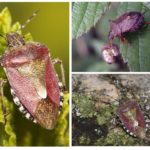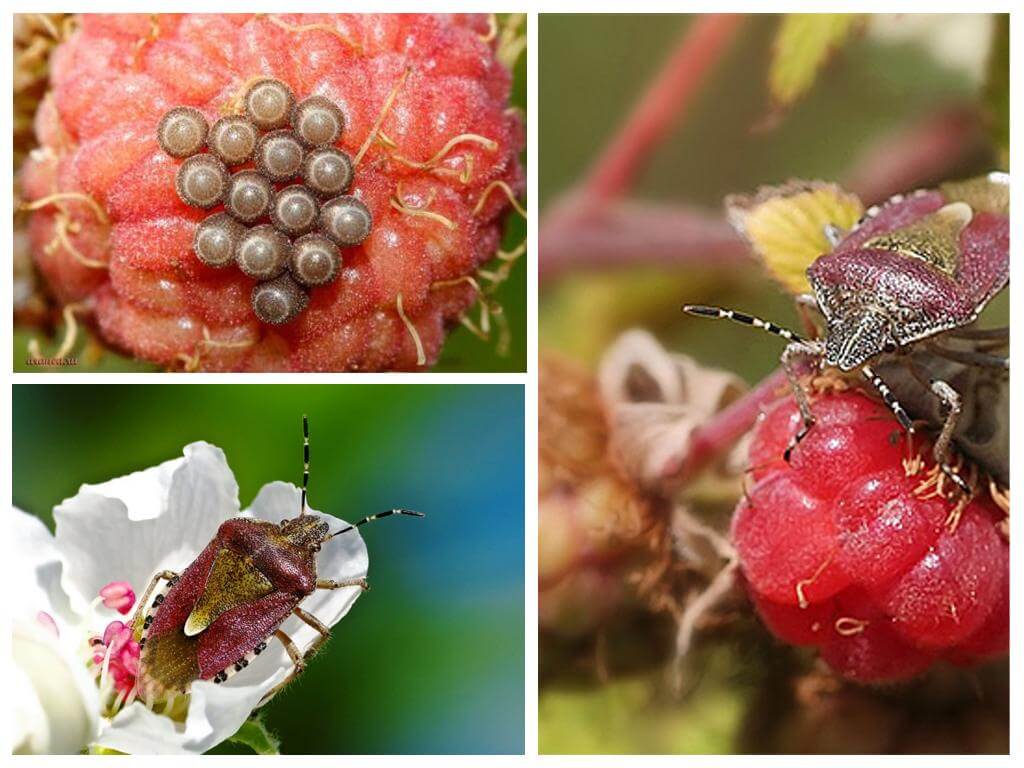Berry bugs
- Berry bug
- Berry bug
- Malathion
In nature, there are more than 4000 species of bedbugswhich differ not only in appearance and habitat, but also way of feeding. Berry bug is one of the representatives of this family, which, like its fellow bears, is harmful to man. What an insect looks like, what it eats, and what kind of lifestyle it leads, this article will tell.
Special features
Berry bug - small size (10-12 mm) is a multi-eating insect, which belongs to the family of moths. A distinctive feature of all members of this family are: a triangular body and a repulsive odor secreted by a special gland at times of danger,why in everyday life these insects are called stink bugs.
On a note!
Cimicinic acid excreted by moths smells unpleasantly and is detrimental to other insects. For a man, it is not dangerous. Also, with a peculiar smell, pests scare their rivals while fighting for the female.
The flat body of the berry bug is grayish-yellow or reddish-brown, with a dense top covered with hairs. Adults can change their color, masking the tone of the surrounding plants. Therefore, it is not surprising that in summertime the color of the shield of burgundy shades, with the arrival of autumn, the cover of the same insect turns brown.
The berry shield leaf differs from its relatives by the sides and antennae, painted in yellow-brown rings. Similar transverse bands are also found in the abdominal part of the body. Below is a photo of berry bugs.
Habitat
Berry bugs live in gardens and vegetable gardens, feeding on sap of leaves, fruits and vegetables. Contrary to their name, they can live on birch and even on coniferous trees. Often there are bugs on raspberries.
The pest bites into the green flesh of the leaf with its proboscis,as evidenced by the brown spots that appeared at the sites of damage. Such insect attacks are fraught with even the death of the plant. The same happens with the affected pest fruits - they dry up prematurely and acquire an unpleasant taste.
Breeding
Winter berry shchitniki spend under fallen leaves. With the arrival of warm days, they leave their shelters. During the absence of fruit and vegetable plantations, the bugs do not even give up weeds. With the appearance of raspberry leaves on the bushes, they settle there for breeding. Bedbugs on currants are also quite common. The berry bug settled on the plant will cause the raspberry berries to become unusable, harming their taste and aroma.
When the berry bushes shed their color, the females of the shield plant lay eggs on the underside of the leaves. In this process, pests take about 10 days. After 1.5-2 months of larvae, the larvae appear, which at first are kept in a group. After a while, they crawl along the branches of the plant, leading a way of life similar to adults. Externally, the larvae are very similar to the mature insects: their body has a gray color and is covered with light hairs.In the process of growth, the infant fluff disappears, and the larva of the berry bug turns into an adult, undergoing several molts.
Ways to fight
The bug does not represent a big threat to harvest. Therefore, it is necessary to fight it with chemical preparations only in case of excessive contamination of the plantations. With a small accumulation of pests, it is preferable to use more benign methods of control. These include:
- picking berry pests - they are harvested by hand, putting them in a container;
- folk remedies - cooking decoctions of onion peel. On a bucket of boiling water you need 200 g of funds. The mixture is infused for 5 days, then filtered and the resulting infusion is sprayed with infected plants every 5 days. Tobacco, yarrow, mustard and wood ash have similar properties;
- landing on the garden or garden plot of zimitifug or black cohosh - the smell of these plants scares berry bugs;
- regular weed control in garden plots and the cleaning of fallen leaves will help to avoid the appearance of shields.
If the struggle with these methods does not give results and the number of bedbugs only increases, the use of toxic chemicals is recommended.Phosphamide, Karbofos or Chlorofos are very popular among gardeners.











